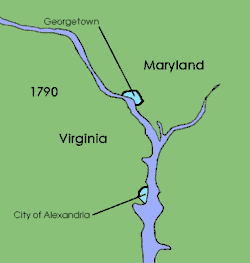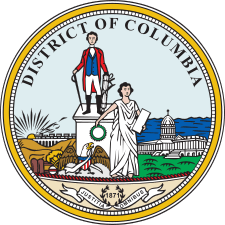District of Columbia Organic Act of 1871
The District of Columbia Organic Act of 1871 is an Act of Congress that repealed the individual charters of the cities of Washington and Georgetown and established a new territorial government for the whole District of Columbia. Though Congress repealed the territorial government in 1874, the legislation was the first to create a single municipal government for the federal district.[1]
.svg.png) | |
| Long title | An Act to provide a Government for the District of Columbia. |
|---|---|
| Nicknames | District of Columbia Organic Act of 1871 |
| Enacted by | the 41st United States Congress |
| Citations | |
| Statutes at Large | 16 Stat. 419 |
| Legislative history | |
| |
History

The passage of the Residence Act in 1790 created a new federal district that would become the capital of the United States. Formed from land donated by the states of Maryland and Virginia, the capital territory already included two large settlements at its creation: the port of Georgetown, Maryland and the town of Alexandria, Virginia. A new capital city named in honor of President George Washington was founded to the east of Georgetown in 1791.
Shortly after establishing operations in the new capital, Congress passed the Organic Act of 1801, which organized the federal territory. The territory within the federal district east of the Potomac formed the new County of Washington, which was governed by a levy court consisting of seven to eleven Justices of the Peace appointed by the President, and was governed by Maryland law as of 1801. The area west of the river became Alexandria County which was governed by Virginia law. In addition, Congress allowed the cities of Washington, Alexandria and Georgetown to each maintain their own municipal governments. In 1846 Alexandria County was returned by Congress to the state of Virginia.
The outbreak of the American Civil War in 1861 led to notable growth in the capital's population due to the expansion of the federal government and a large influx of emancipated slaves.[2] By 1870, the District's population had grown 75% to nearly 132,000 residents.[3] Growth was even more dramatic within the County of Washington, where the population more than doubled as people escaped the crowded city.[4]
The individual local governments within the District were insufficient to handle the population growth. Living conditions were poor throughout the capital, which still had dirt roads and lacked basic sanitation. The situation was so bad that some lawmakers in Congress even suggested moving the capital out further west, but President Ulysses S. Grant refused to consider the proposals.[5]
Effect
Instead, Congress passed the Organic Act of 1871, which revoked the individual charters of the cities of Washington and Georgetown and combined them with Washington County to create a unified territorial government for the entire District of Columbia.[6] The new government consisted of an appointed governor and 11-member council, a locally elected 22-member assembly, and a board of public works charged with modernizing the city.[7] The Seal of the District of Columbia features the date 1871, recognizing the year the District's government was incorporated.[8]
The Act did not establish a new city or city government within the District. Regarding a city , it stated that "the District of Columbia be, and is hereby, declared to be the successor of said corporations (Washington and Georgetown)". In the present day, the name "Washington" is commonly used to refer to the entire District, but there is no longer an official entity in the District by that name.[9]
In 1873, President Grant appointed an influential member of the board of public works, Alexander Robey Shepherd, to the post of governor. Shepherd authorized large-scale municipal projects, which greatly modernized Washington. In doing so however, the governor spent three times the money that had been budgeted for capital improvements, bankrupting the city.[10] In 1874, Congress replaced the District's quasi-elected territorial government with an appointed three-member Board of Commissioners. Direct rule by Congress continued until the passage of the District of Columbia Home Rule Act in 1973.[11]
See also
Notes
- Tindall, William (1909). Origin and government of the District of Columbia. J. Byrne & co. pp. 9.
- McQuirter, Marya Annette. "African Americans in Washington, DC: 1800-1975". A Brief History of African Americans in Washington, D.C. Archived from the original on September 20, 2011. Retrieved August 12, 2011.
- "Historical Census Statistics on Population Totals By Race, 1790 to 1990" (PDF). United States Census Bureau. September 13, 2002. Archived from the original (PDF) on July 26, 2008. Retrieved August 13, 2011.
- "1870 Census Information". United States Census Bureau. Archived from the original on 27 March 2010. Retrieved 2 June 2012.
- Bordewich, Fergus M. (2008). Washington: the making of the American capital. HarperCollins. p. 272. ISBN 978-0-06-084238-3.
- Dodd, Walter Fairleigh (1909). The government of the District of Columbia. Washington, D.C.: John Byrne & Co. p. 4.
- "An Act to provide a Government for the District of Columbia". Statutes at Large, 41st Congress, 3rd Session. Library of Congress; Feb. 21, 1871, 41st Congress, 3rd session, chap. 62, 16 Stat. 419. Retrieved July 10, 2011.
- "Official Symbols of the District of Columbia". About DC. Archived from the original on 5 February 2006. Retrieved 18 April 2012.
- "An Act to provide a government for the District of Columbia" (PDF). Library of Congress; Feb. 21, 1871, 41st Congress, 3rd session, chap. 62, 16 Stat. 419. Retrieved 10 April 2020.
- Wilcox, Delos Franklin (1910). Great cities in America: their problems and their government. The Macmillan Company. pp. 27–30.
- "History of Self-Government in the District of Columbia". Council of the District of Columbia. 2008. Archived from the original on March 31, 2009. Retrieved December 29, 2008.
External links
- "An Act to provide a Government for the District of Columbia", Statutes at Large, Library of Congress
